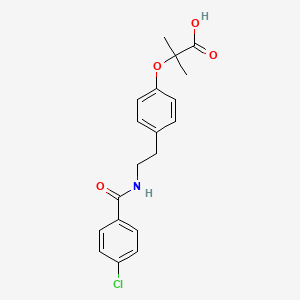m6A-centered Drug Response Information
General Information of the Drug (ID: M6APDG01488)
| Name |
Bezafibrate
|
||||
|---|---|---|---|---|---|
| Synonyms |
Azufibrat; Befibrat; Befizal; BezaLande; BezaPuren; Bezabeta; Bezacur; Bezafibrat; Bezafibrato; Bezafibratum; Bezafisal;Bezalip; Bezamerck; Bezatol; Cedur; Difaterol; Durabezur; Eulitop; Lipox; Reducterol; Sklerofibrat; Solibay; Azupharma Brand of Bezafibrate; Bayer Brand of Bezafibrate; Berlin Chemie Brand of Bezafibrate; Betapharm Brand of Bezafibrate; Beza Lande; Beza Puren; Bezafibrat PB; Bezafibrate Azupharma Brand; Bezafibrate Bayer Brand; Bezafibrate Betapharm Brand; Bezafibrate Cryopharma Brand; Bezafibrate Elfar Brand; Bezafibrate Hennig Brand; Bezafibrate Hexal Brand; Bezafibrate Isis Brand; Bezafibrate Lakeside Brand; Bezafibrate Merckle Brand; Bezafibrate Roche Brand; Bezafibrate Synthelabo Brand; Bezafibrate TAD Brand; Bezafibrate Teva Brand; Bezafibrato [Spanish]; Bezalip Retard; Bezatol SR; Boehringer Mannheim Brand of Bezafibrate; Cryopharma Brand of Bezafibrate; Elfar Brand of Bezafibrate;Hennig Brand of Bezafibrate; Hexal Brand of Bezafibrate; Isis Brand of Bezafibrate; Lakeside Brand of Bezafibrate; Merckle Brand of Bezafibrate; Regadrin B; Roche Brand of Bezafibrate; Synthelabo Brand of Bezafibrate; TAD Brand of Bezafibrate; Teva Brand of Bezafibrate; BM 15075; LO 44; BF-759; BM 15.075; BM-15075; BM15.075; Berlin-Chemie Brand of Bezafibrate; Beza-Lande; Beza-Puren; Bezafibrate Berlin-Chemie Brand; Bezafibrato [INN-Spanish]; Bezafibratum [INN-Latin]; Bezalip (TN); Bezatol SR (TN); PB, Bezafibrat; BM-15.075; Bezafibrate (JP15/USAN/INN); Bezafibrate [USAN:BAN:INN:JAN]; A-[4-(4-chlorobenzoylaminoethyl)phenoxy]isobutyric acid; 2-(4-{2-[(4-chlorobenzoyl)amino]ethyl}phenoxy)-2-methylpropanoic acid; 2-(p-(2-(p-Chlorobenzamido)ethyl)phenoxy)-2-methylpropionic acid; 2-[4-(2-[4-Chlorobenzamido]ethyl)-phenoxy]-2-methylpropanoic acid; 2-[4-[2-(4-Chlorobenzamido)ethyl]phenoxy]-2-methylpropanoic acid; 2-[4-[2-(4-Chlorobenzamido)ethyl]phenoxy]isobutyric Acid; 2-[4-[2-[(4-chlorobenzoyl)amino]ethyl]phenoxy]-2-methylpropanoic acid
Click to Show/Hide
|
||||
| Status |
Approved
|
||||
| Structure |
 |
||||
| Formula |
C19H20ClNO4
|
||||
| InChI |
1S/C19H20ClNO4/c1-19(2,18(23)24)25-16-9-3-13(4-10-16)11-12-21-17(22)14-5-7-15(20)8-6-14/h3-10H,11-12H2,1-2H3,(H,21,22)(H,23,24)
|
||||
| InChIKey |
IIBYAHWJQTYFKB-UHFFFAOYSA-N
|
||||
| PubChem CID | |||||
| TTD Drug ID | |||||
Target Gene(s) and Their Upstream m6A Regulator, Together with the Effect of Target Gene(s) in Drug Response
The target genes involved in drug-target interaction (such as drug-metabolizing enzymes, drug transporters and therapeutic targets) and drug-mediated cell death signaling (including modulating DNA damage and repair capacity, escaping from drug-induced apoptosis, autophagy, cellular metabolic reprogramming, oncogenic bypass signaling, cell microenvironment, cell stemness, etc.) could be regulated by m6A regulator(s) and affected their corresponding drug response. You can browse detailed information on drug-related target gene(s) mediated by m6A regulators.
Peroxisome proliferator-activated receptor alpha (PPARA)
Fat mass and obesity-associated protein (FTO)
| In total 1 mechanisms lead to this potential drug response | ||||
| Response Summary | Peroxisome proliferator-activated receptor alpha (PPARA) is a therapeutic target for Bezafibrate. The Fat mass and obesity-associated protein (FTO) has potential in affecting the response of Bezafibrate through regulating the expression of Peroxisome proliferator-activated receptor alpha (PPARA). | [1], [2] | ||
Methyltransferase-like 14 (METTL14)
| In total 1 mechanisms lead to this potential drug response | ||||
| Response Summary | Peroxisome proliferator-activated receptor alpha (PPARA) is a therapeutic target for Bezafibrate. The Methyltransferase-like 14 (METTL14) has potential in affecting the response of Bezafibrate through regulating the expression of Peroxisome proliferator-activated receptor alpha (PPARA). | [2], [3] | ||
Methyltransferase-like 3 (METTL3)
| In total 1 mechanisms lead to this potential drug response | ||||
| Response Summary | Peroxisome proliferator-activated receptor alpha (PPARA) is a therapeutic target for Bezafibrate. The Methyltransferase-like 3 (METTL3) has potential in affecting the response of Bezafibrate through regulating the expression of Peroxisome proliferator-activated receptor alpha (PPARA). | [2], [4] | ||
Wilms tumor 1-associating protein (WTAP)
| In total 1 mechanisms lead to this potential drug response | ||||
| Response Summary | Peroxisome proliferator-activated receptor alpha (PPARA) is a therapeutic target for Bezafibrate. The Wilms tumor 1-associating protein (WTAP) has potential in affecting the response of Bezafibrate through regulating the expression of Peroxisome proliferator-activated receptor alpha (PPARA). | [2], [3] | ||
YTH domain-containing family protein 2 (YTHDF2)
| In total 1 mechanisms lead to this potential drug response | ||||
| Response Summary | Peroxisome proliferator-activated receptor alpha (PPARA) is a therapeutic target for Bezafibrate. The YTH domain-containing family protein 2 (YTHDF2) has potential in affecting the response of Bezafibrate through regulating the expression of Peroxisome proliferator-activated receptor alpha (PPARA). | [2], [4] | ||
References